Surface Mount Technology (SMT) Market Size
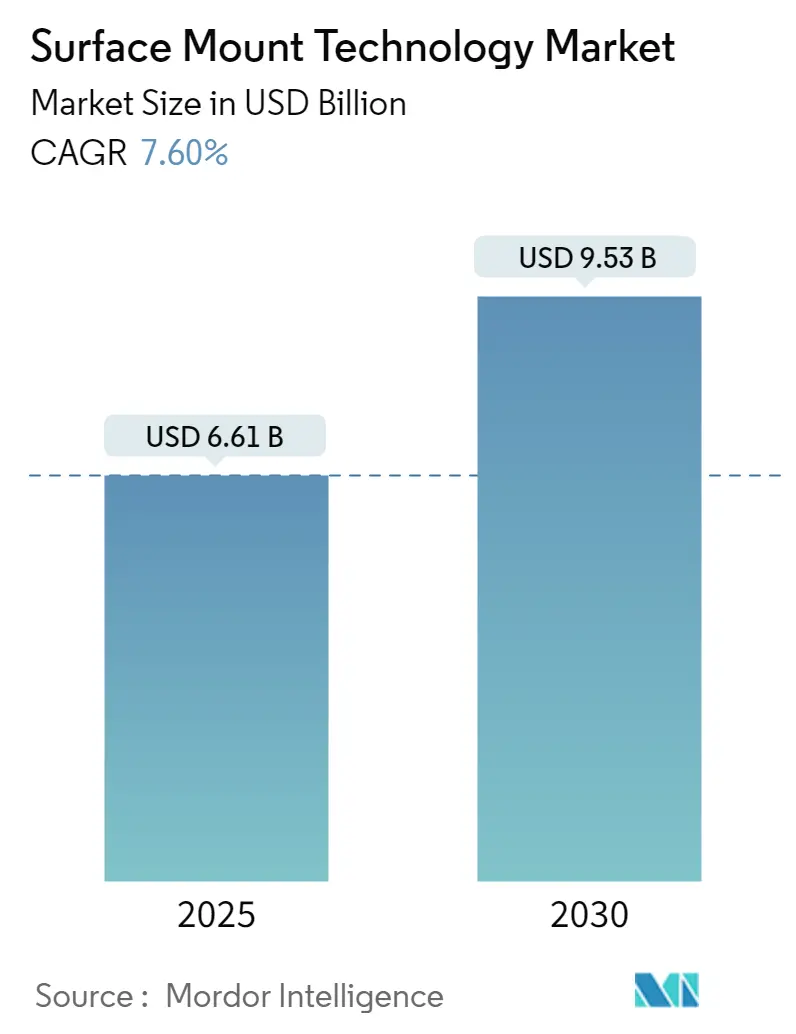
| Study Period | 2019 - 2030 |
| Market Size (2025) | USD 6.61 Billion |
| Market Size (2030) | USD 9.53 Billion |
| CAGR (2025 - 2030) | 7.60 % |
| Fastest Growing Market | Asia Pacific |
| Largest Market | Asia Pacific |
| Market Concentration | Low |
Major Players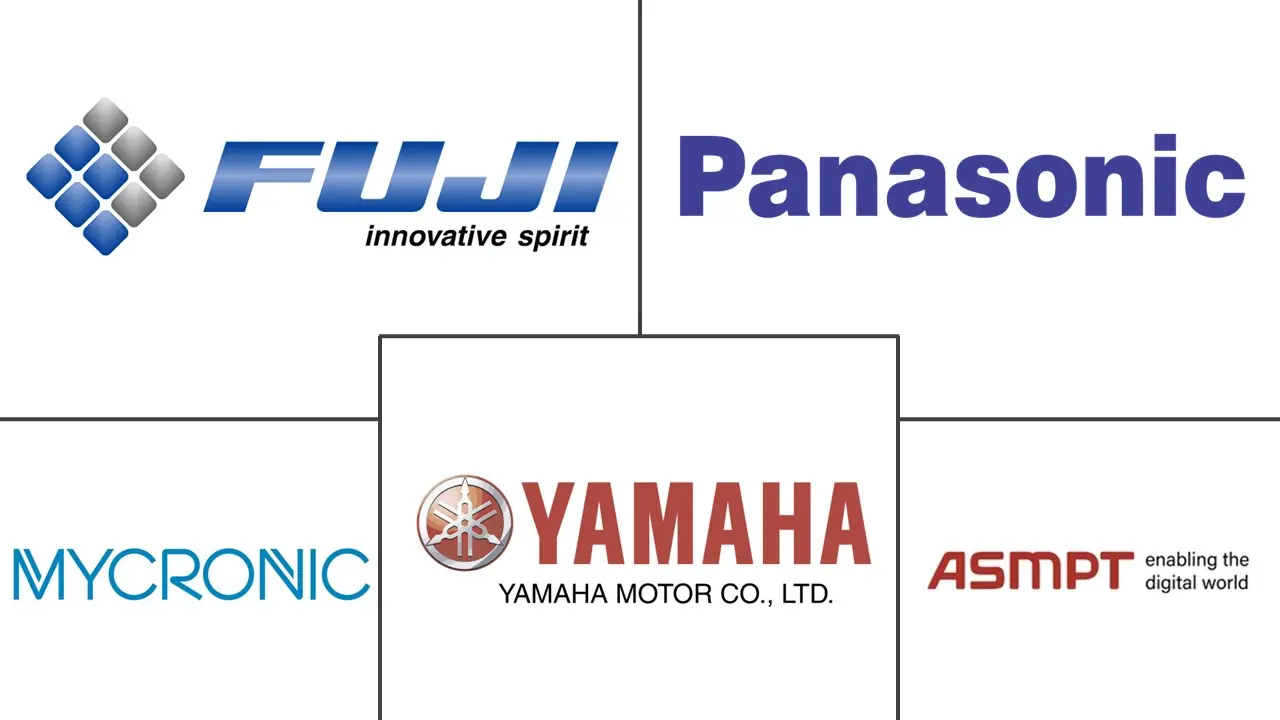
*Disclaimer: Major Players sorted in no particular order |
Need a report that reflects how COVID-19 has impacted this market and its growth?
Surface Mount Technology (SMT) Market Analysis
The Surface Mount Technology Market size is estimated at USD 6.61 billion in 2025, and is expected to reach USD 9.53 billion by 2030, at a CAGR of 7.6% during the forecast period (2025-2030).
The surface mount technology landscape is being significantly shaped by the rapid expansion of data center infrastructure globally. As of March 2024, the United States leads with 5,381 data centers, followed by Germany with 521 and the United Kingdom with 514 facilities, highlighting the growing demand for advanced electronic components in digital infrastructure. This expansion is driven by increasing cloud adoption, artificial intelligence applications, and the need for enhanced data processing capabilities. Major technology companies are making substantial investments in data center development, with companies like Amazon Web Services announcing significant projects such as the USD 10 billion investment in Madison County data center complexes.
The defense and industrial automation sectors are emerging as crucial growth drivers for surface mount technology adoption. The U.S. Congressional Budget Office projects defense spending to increase from USD 746 billion in 2023 to USD 1.1 trillion by 2033, indicating sustained demand for advanced electronic systems in military applications. In the industrial sector, the International Federation of Robotics forecasts annual industrial robot installations to reach 718,000 units by 2026, emphasizing the growing need for sophisticated electronic components in automation systems. This trend underscores the importance of the electronics manufacturing industry in advancing automation technologies.
The telecommunications industry is undergoing a significant transformation with the widespread deployment of 5G infrastructure. According to GSMA predictions, approximately one-third of the global population will have access to 5G networks by 2025, with global 5G subscriptions projected to reach 5.3 billion by 2029. This rapid expansion is driving innovations in surface mount technology, particularly in the development of compact, high-performance components essential for 5G equipment and related telecommunications infrastructure. The role of electronic manufacturing services is critical in supporting this technological evolution.
The push towards grid modernization and sustainable energy systems is creating new opportunities for surface mount technology applications. In Germany alone, the energy industry BDEW has identified a need for EUR 721 billion in investments by 2030, with EUR 131 billion specifically allocated for grid modernization and expansion. This transformation requires advanced electronic components for smart meters, grid control systems, and power management devices, driving innovation in surface mount technology solutions for energy applications. Companies are increasingly focusing on developing components that can withstand harsh environmental conditions while maintaining high performance and reliability in smart grid applications. The electronic manufacturing services industry plays a pivotal role in delivering these advanced solutions.
Surface Mount Technology (SMT) Market Trends
Rising Demand for Miniaturization of Technology
The increasing trend toward miniaturization has become a fundamental driver of surface mount technology adoption across multiple industries. According to industry data, modern smartphones typically incorporate between 900 and 1100 multilayer ceramic capacitors (MLCCs), highlighting the critical need for compact SMT components integration. This trend is further exemplified by recent innovations, such as Kyocera Corporation's introduction of the KGM03 Series MLCCs in April 2023, which measure a mere 0.6 mm x 0.3 mm, enabling designers to fulfill system requirements with fewer components while occupying minimal space. The push for miniaturization is particularly evident in the telecommunications sector, where GSMA predicts that global 5G subscriptions will surpass 5.3 billion by 2029, necessitating increasingly compact and sophisticated electronic components.
The healthcare and automotive sectors are experiencing parallel demands for miniaturization, driving surface mount technology adoption. In the medical field, the development of smaller, more sophisticated devices like pacemakers, hearing aids, and diagnostic equipment relies heavily on SMT capabilities. This is evidenced by recent developments such as ROHM Limited's introduction of the industry's most compact silicon capacitor series, the BTD1RVFL, in November 2023, which achieved a 55% reduction in surface mounting area compared to standard products. In the automotive sector, the integration of advanced driver-assistance systems (ADAS), infotainment systems, and vehicle control systems requires increasingly compact electronic components, with surface mount technology enabling the precise mounting of minuscule electronic components on circuit boards for efficient and reliable operation.
Fewer Holes Required to Drill on PCBs Compared to Other Technologies
The significant reduction in drilling requirements offered by surface mount technology represents a crucial advantage driving its adoption across the electronics manufacturing industry. By eliminating the need for through-holes, manufacturers can achieve substantial time and cost savings while enabling higher component density on printed circuit boards. This advantage is particularly evident in recent industry developments, such as Yamaha Motor's introduction of 'Perfect Fit Automation for Surface Mount Technology' in May 2024, which demonstrates how the elimination of drilling processes contributes to more efficient and automated production workflows. The reduced drilling requirement also translates to improved signal integrity and electrical performance, as shorter connection paths minimize signal distortion and interference.
The efficiency gains from reduced drilling requirements are further amplified in high-volume production environments. For instance, in September 2023, Hyve Solutions Corporation implemented advanced SMT lines with enhanced SMT equipment and inspection technologies, capitalizing on the streamlined production processes enabled by surface mounting. The elimination of drilling requirements also facilitates the adoption of more complex multilayer designs and higher component density, as demonstrated by Continental Device India Limited's inauguration of a new SiC Surface Mount Technology assembly line in February 2024. This advancement in manufacturing capability allows for the production of sophisticated auto-grade devices while maintaining efficient production processes through reduced drilling requirements.
Segment Analysis: By Component
Passive Components Segment in Surface Mount Technology Market
The passive components segment dominates the surface mount technology market, holding approximately 57% market share in 2024. This segment encompasses critical SMT components like resistors and capacitors that are extensively utilized across various electronic applications. The widespread adoption of passive components is driven by their fundamental role in electronic circuit design, particularly in consumer electronics, automotive applications, and industrial equipment. These components are essential for functions such as current limitation, voltage division, and energy storage in electronic circuits. The increasing demand for miniaturization in electronic devices has particularly benefited surface mount passive components, as they offer significant space savings compared to traditional through-hole components. The segment's dominance is further reinforced by the growing adoption of multilayer ceramic capacitors (MLCCs) in smartphones, automotive electronics, and industrial automation systems.
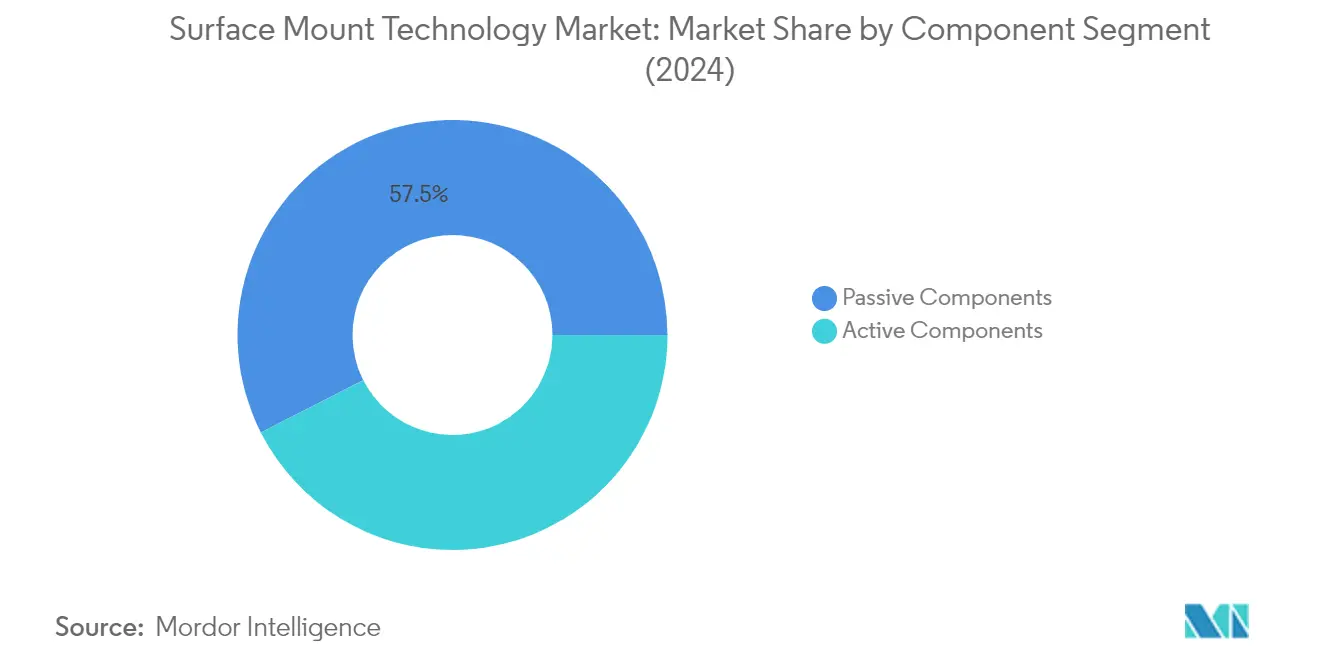
Active Components Segment in Surface Mount Technology Market
The active components segment is projected to exhibit the highest growth rate of approximately 8% during the forecast period 2024-2029. This robust growth is primarily attributed to the increasing integration of advanced semiconductors and integrated circuits in modern electronic devices. The segment's growth is being driven by the rising demand for sophisticated electronic systems in automotive electronics, particularly in electric vehicles and advanced driver assistance systems (ADAS). The proliferation of Internet of Things (IoT) devices and the ongoing deployment of 5G infrastructure are creating substantial opportunities for surface mount active components. Additionally, the trend toward more powerful and energy-efficient electronic devices is boosting the demand for advanced surface mount transistors and integrated circuits. The segment is also benefiting from innovations in semiconductor assembly technologies and the growing adoption of system-on-chip (SoC) solutions in various applications.
Segment Analysis: By End-User Industry
Consumer Electronics Segment in Surface Mount Technology Market
The consumer electronics segment dominates the surface mount technology market, commanding approximately 44% market share in 2024. This significant market position is driven by the increasing adoption of SMT in manufacturing smartphones, laptops, tablets, televisions, gaming consoles, and smart home devices. The segment's dominance is further strengthened by the growing trend of miniaturization in consumer electronics, where SMT enables the production of smaller and more compact electronic devices by facilitating direct component placement onto printed circuit boards. The technology's ability to support high-density component placement while maintaining reliability and performance makes it particularly valuable in consumer electronics manufacturing. Additionally, the surge in 5G technology adoption has created new demands for SMT in producing advanced mobile devices and telecommunications equipment, further solidifying the segment's market leadership.
Automotive Segment in Surface Mount Technology Market
The automotive segment is emerging as the fastest-growing sector in the surface mount technology market, with a projected growth rate of approximately 9% during 2024-2029. This remarkable growth is primarily driven by the increasing integration of electronic components in modern vehicles, particularly in advanced driver-assistance systems (ADAS), infotainment systems, and vehicle control systems. The rapid expansion of electric vehicle production globally has created substantial demand for SMT applications in battery management systems and power electronics. The automotive industry's shift towards autonomous vehicles and connected car technologies has further accelerated the adoption of SMT, as these advanced features require sophisticated electronic control units and sensors. Additionally, the growing focus on vehicle electrification and the integration of smart features in automobiles continue to drive innovation in automotive electronics manufacturing, creating new opportunities for SMT applications.
Remaining Segments in End-User Industry
The surface mount technology market encompasses several other significant segments, including industrial electronics, aerospace and defense, healthcare, and other end-use industries. The industrial electronics segment plays a crucial role in manufacturing automation equipment, robotics, and control systems. The aerospace and defense sector utilizes SMT for producing high-reliability electronic components for aircraft, satellites, and military applications. The healthcare segment implements SMT in medical devices, diagnostic equipment, and patient monitoring systems. Other end-use industries, including telecommunications and data centers, contribute to market growth through their increasing demand for advanced electronic components. Each of these segments brings unique requirements and applications to the SMT market, driving innovation and technological advancement in their respective fields.
Surface Mount Technology Market Geography Segment Analysis
Surface Mount Technology Market in North America
The North American surface mount technology market holds approximately 23% of the global market share in 2024, establishing itself as a crucial region in the global landscape. The region's dominance is primarily driven by the increasing adoption of advanced electronics in the automotive, industrial, and consumer electronics sectors. The United States leads the regional market with its robust semiconductor industry and strong presence of major electronics manufacturers. The market is characterized by significant investments in research and development, particularly in miniaturization technologies and automated assembly processes. The presence of established players and their focus on technological advancement has created a highly competitive environment. The region's strong emphasis on quality control and precision manufacturing has made it a benchmark for global surface mount technology standards. Additionally, the growing demand for electric vehicles and renewable energy systems has created new opportunities for SMT applications in power electronics and control systems. The market also benefits from the region's advanced infrastructure and skilled workforce, enabling the efficient implementation of sophisticated SMT solutions.
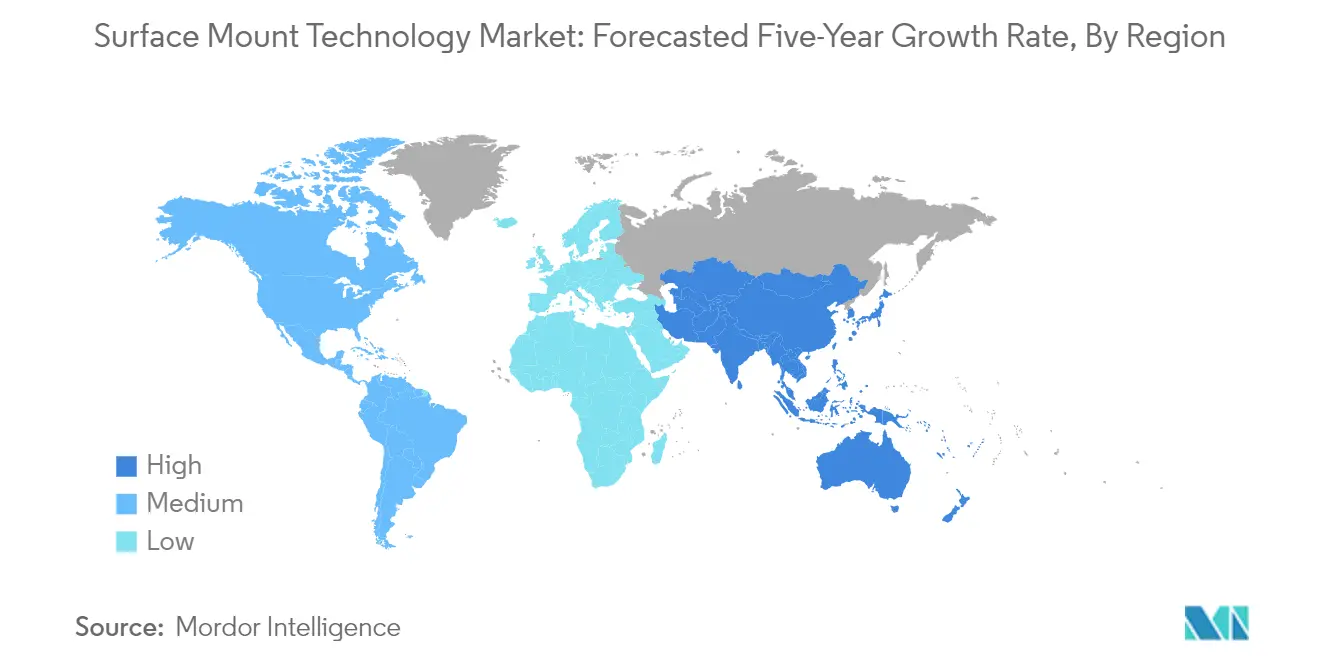
Surface Mount Technology Market in Europe
The European surface mount technology market has demonstrated robust growth, experiencing approximately 7% growth annually from 2019 to 2024. The region's market is characterized by its strong focus on industrial automation and Industry 4.0 initiatives, which have significantly driven the adoption of surface mount technology. Germany leads the regional market with its advanced automotive manufacturing sector and strong emphasis on precision engineering. The region's commitment to sustainable manufacturing practices has led to innovations in energy-efficient SMT equipment and eco-friendly soldering processes. European manufacturers have particularly excelled in developing specialized SMT solutions for high-reliability applications in aerospace and medical devices. The market has benefited from strong collaboration between industry players and research institutions, fostering continuous innovation in SMT technologies. The region's stringent quality standards and regulatory framework have ensured the development of highly reliable SMT solutions. Furthermore, the increasing focus on electric vehicle production has created new opportunities for SMT applications in automotive electronics.
Surface Mount Technology Market in Asia-Pacific
The Asia-Pacific surface mount technology market is projected to grow at a CAGR of 8.5% from 2024 to 2029, establishing itself as the fastest-growing region globally. The region has emerged as a global manufacturing hub for electronic components and devices, with countries like China, Japan, South Korea, and Taiwan leading the way. The market's growth is driven by the presence of major electronics manufacturers and the continuous expansion of manufacturing facilities across the region. The increasing adoption of automation in manufacturing processes has significantly boosted the demand for advanced SMT solutions. Local manufacturers are increasingly investing in state-of-the-art SMT equipment to enhance their production capabilities and meet global quality standards. The region's strong focus on consumer electronics manufacturing has created substantial opportunities for SMT applications. The presence of a robust supply chain network and cost-effective manufacturing capabilities has attracted global electronics manufacturers to establish their production facilities in the region. Additionally, government initiatives supporting electronics manufacturing have created a favorable environment for market growth.
Surface Mount Technology Market in Rest of the World
The Rest of the World region, comprising Latin America and the Middle East & Africa, represents an emerging market for the SMT industry with significant growth potential. The market in these regions is primarily driven by increasing investments in electronics manufacturing facilities and the growing adoption of automation technologies. Countries in the Middle East are focusing on diversifying their economies beyond oil dependency, leading to investments in electronics manufacturing and technology sectors. Latin American countries are witnessing growing domestic demand for electronic products, spurring investments in local manufacturing capabilities. The market is characterized by increasing adoption of SMT in automotive electronics manufacturing and consumer electronics assembly. Government initiatives to promote local manufacturing and attract foreign investments have created new opportunities for market growth. The region is also witnessing growing adoption of SMT in medical device manufacturing and aerospace applications. The presence of a skilled workforce and improving infrastructure has made these regions attractive for electronics manufacturers looking to expand their operations.
Surface Mount Technology (SMT) Industry Overview
Top Companies in Surface Mount Technology Market
The surface mount technology companies market features prominent players like Fuji Corporation, Yamaha Motor, Mycronic AB, ASMPT, Panasonic Corporation, and Nordson Corporation leading the innovation charge. These SMT vendors demonstrate a strong commitment to technological advancement through continuous investment in research and development, particularly focusing on automation, artificial intelligence, and smart manufacturing capabilities. The industry witnesses regular product launches targeting enhanced precision, speed, and flexibility in SMT assembly processes. Companies are increasingly emphasizing sustainable manufacturing practices while expanding their global footprint through strategic partnerships and regional manufacturing facilities. Market leaders are also prioritizing comprehensive customer support services, offering end-to-end solutions from development and design to after-sales support, while simultaneously working on reducing setup costs and improving operational efficiency through modular product designs.
Global Leaders Dominate Consolidated Market Structure
The surface mount technology market exhibits a relatively consolidated structure dominated by established global players with extensive manufacturing capabilities and robust distribution networks. These market leaders, primarily based in Japan, Europe, and the United States, leverage their strong financial positions to maintain technological leadership and market presence. Many of these companies operate as part of larger industrial conglomerates, benefiting from shared resources, cross-industry expertise, and established brand recognition. The market has witnessed strategic acquisitions aimed at expanding product portfolios, gaining access to new technologies, and strengthening regional presence, particularly in emerging markets.
The competitive landscape is characterized by high entry barriers due to significant capital requirements, technical expertise needs, and established customer relationships. While global players dominate the high-end market segment, regional players maintain their presence in specific geographic markets or specialized product categories. The industry sees ongoing collaboration between equipment manufacturers and technology providers to enhance product capabilities and address evolving customer needs. Market participants increasingly focus on developing comprehensive solution packages that include hardware, software, and services, moving beyond traditional equipment-only offerings.
Innovation and Adaptability Drive Market Success
Success in the SMT equipment market increasingly depends on companies' ability to innovate while maintaining cost competitiveness and operational flexibility. Market leaders are strengthening their positions through investments in next-generation technologies like artificial intelligence, machine learning, and Industry 4.0 capabilities. Companies are also focusing on developing modular and scalable solutions that can accommodate varying production volumes and requirements, while simultaneously expanding their service offerings to include predictive maintenance, remote monitoring, and process optimization capabilities. The ability to provide comprehensive solutions that address the entire SMT assembly process, from design to final inspection, has become a crucial differentiator in the market.
For new entrants and smaller players, success lies in identifying and serving niche market segments or specific regional markets where they can build specialized expertise. Companies must focus on developing strong relationships with key component suppliers and maintaining robust quality control systems to meet increasingly stringent industry standards. The market shows particular sensitivity to end-user industries' demands for higher precision, faster production speeds, and improved reliability. Regulatory compliance, particularly regarding environmental standards and safety requirements, continues to shape product development and manufacturing processes. Companies that can effectively balance these requirements while maintaining competitive pricing and reliable after-sales support are better positioned for long-term success in the market. Additionally, the integration of pick-and-place equipment is crucial for enhancing production efficiency and meeting the growing demands of precision in assembly processes.
Surface Mount Technology (SMT) Market Leaders
-
Fuji Corporation
-
Yamaha Motor Co. Ltd
-
Mycronic AB
-
ASMPT
-
Panasonic Corporation
*Disclaimer: Major Players sorted in no particular order
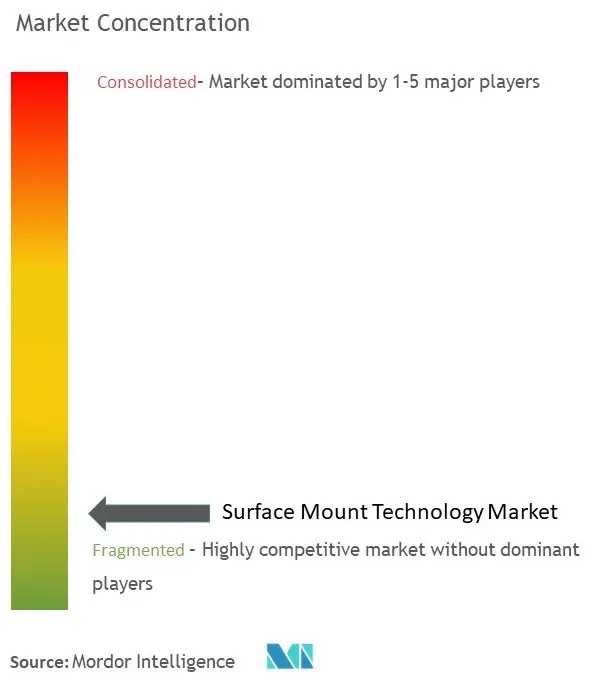
Surface Mount Technology (SMT) Market News
- June 2024 - Beifu Electronic Technology Co. Ltd, based in Shanghai, has recently integrated Europlacer's cutting-edge pick-and-place technology into its operations. Beifu Electronic has significantly ramped up its production efficiency in the last two years, courtesy of Europlacer's Atom pick-and-place range. With a pressing need for swift changeovers and enhanced flexibility, Beifu Electronic turned to Europlacer's Atom technology, finding it the ideal fit. Due to the Atom range, Beifu Electric has bolstered its production capabilities and slashed turnaround times while upholding its stringent quality benchmarks.
- April 2024 - TVS Electronics is set to venture into the electronics manufacturing services (EMS) sector, focusing on defense and railway products. The company is strategizing to ramp up production at its surface mount technology (SMT) line, which commenced operations in February this year. The SMT line currently serves internal demands at its Tumakuru plant in Karnataka. In a bid to expand, TVS Electronics is engaging with various tech partners, with a vision to have six operational SMT lines at the Tumakuru facility by 2028. Notably, the company collaborates with partners from Taiwan, South Korea, Japan, and China for its thermal and barcode printer offerings.
Surface Mount Technology (SMT) Market Report - Table of Contents
1. INTRODUCTION
1.1 Study Assumptions and Market Definition
1.2 Scope of the Study
2. RESEARCH METHODOLOGY
3. EXECUTIVE SUMMARY
4. MARKET INSIGHTS
4.1 Market Overview
4.2 Industry Value Chain Analysis
4.3 Industry Attractiveness - Porter's Five Forces Analysis
4.3.1 Bargaining Power of Suppliers
4.3.2 Bargaining Power of Buyers
4.3.3 Threat of New Entrants
4.3.4 Threat of Substitutes
4.3.5 Intensity of Competitive Rivalry
4.4 Impact of COVID-19 on the Surface Mount Technology Market
5. MARKET DYNAMICS
5.1 Rising Demand For Miniaturization of Technology
5.1.1 Fewer Holes Required to Drill on PCBs Compared to Other Technologies
5.2 Market Challenges
5.2.1 SMT is Unsuitable for Any Large, High-Power and High-Voltage Parts and Parts Undergoing Frequent Mechanical Stress
5.2.2 High Initial Cost and Rework Issues
6. MARKET SEGMENTATION
6.1 By Component
6.1.1 Passive Components
6.1.1.1 Resistors
6.1.1.2 Capacitors
6.1.2 Active Components
6.1.2.1 Transistors
6.1.2.2 Integrated Circuits
6.2 By End-user Industry
6.2.1 Consumer Electronics
6.2.2 Automotive
6.2.3 Industrial Electronics
6.2.4 Aerospace and Defense
6.2.5 Healthcare
6.2.6 Other End-user Industries
6.3 By Geography***
6.3.1 North America
6.3.2 Europe
6.3.3 Asia
6.3.4 Australia and New Zealand
6.3.5 Latin America
6.3.6 Middle East and Africa
7. COMPETITIVE LANDSCAPE
7.1 Company Profiles*
7.1.1 Fuji Corporation
7.1.2 Yamaha Motor Co. Ltd
7.1.3 Mycronic AB
7.1.4 ASMPT
7.1.5 Panasonic Corporation
7.1.6 Nordson Corporation
7.1.7 Juki Corporation
7.1.8 Hanwa Precision Machinery Co. Ltd
7.1.9 Zhejiang Neoden Technology Co. Ltd
7.1.10 Europlacer Limited
7.1.11 Viscom SE
8. INVESTMENT ANALYSIS
9. MARKET OPPORTUNITIES AND FUTURE TRENDS
Surface Mount Technology (SMT) Industry Segmentation
Surface Mount Technology (SMT) is utilized in the electronic assembly to mount electronic components to the printed circuit board's (PCB) surface instead of inserting components through holes as with conventional assembly. SMT was developed to significantly reduce manufacturing costs and make more efficient use of PCB space.
The SMT market is segmented by component (passive components (resistors, capacitors), active components (transistors, integrated circuits), end-user industry (consumer electronics, automotive, industrial electronics, aerospace and defense, healthcare, and other end-user industries), and by geography (North America, Europe, Asia-Pacific, Latin America, Middle East and Africa). The report offers value terms in USD for the above-mentioned segments.
| By Component | ||||
| ||||
|
| By End-user Industry | |
| Consumer Electronics | |
| Automotive | |
| Industrial Electronics | |
| Aerospace and Defense | |
| Healthcare | |
| Other End-user Industries |
| By Geography*** | |
| North America | |
| Europe | |
| Asia | |
| Australia and New Zealand | |
| Latin America | |
| Middle East and Africa |
Surface Mount Technology (SMT) Market Research FAQs
How big is the Surface Mount Technology Market?
The Surface Mount Technology Market size is expected to reach USD 6.61 billion in 2025 and grow at a CAGR of 7.60% to reach USD 9.53 billion by 2030.
What is the current Surface Mount Technology Market size?
In 2025, the Surface Mount Technology Market size is expected to reach USD 6.61 billion.
Who are the key players in Surface Mount Technology Market?
Fuji Corporation, Yamaha Motor Co. Ltd, Mycronic AB, ASMPT and Panasonic Corporation are the major companies operating in the Surface Mount Technology Market.
Which is the fastest growing region in Surface Mount Technology Market?
Asia Pacific is estimated to grow at the highest CAGR over the forecast period (2025-2030).
Which region has the biggest share in Surface Mount Technology Market?
In 2025, the Asia Pacific accounts for the largest market share in Surface Mount Technology Market.
What years does this Surface Mount Technology Market cover, and what was the market size in 2024?
In 2024, the Surface Mount Technology Market size was estimated at USD 6.11 billion. The report covers the Surface Mount Technology Market historical market size for years: 2019, 2020, 2021, 2022, 2023 and 2024. The report also forecasts the Surface Mount Technology Market size for years: 2025, 2026, 2027, 2028, 2029 and 2030.
Surface Mount Technology Market Research
Mordor Intelligence provides a comprehensive analysis of the surface mount technology (SMT) industry. Our expertise spans electronic manufacturing services and the broader electronics manufacturing sectors. The research covers the full range of SMT equipment, such as pick and place equipment, SMT reflow oven systems, and SMT stencil printer technologies. Additionally, the report offers extensive insights into PCB assembly processes, semiconductor assembly developments, and new trends in electronic assembly automation.
Stakeholders in the electronic manufacturing services industry gain valuable insights from our analysis of SMT component innovations, SMT solder paste applications, and SMT adhesive technologies. The report, available for download in a convenient PDF format, examines crucial aspects of automated assembly equipment and electronics production equipment. Manufacturers, suppliers, and investors benefit from detailed SMT outlook projections and analysis of leading SMT vendors within the electronics assembly automation landscape. Our comprehensive coverage includes emerging trends in printed circuit board assembly and strategic developments in the PCB assembly industry.



